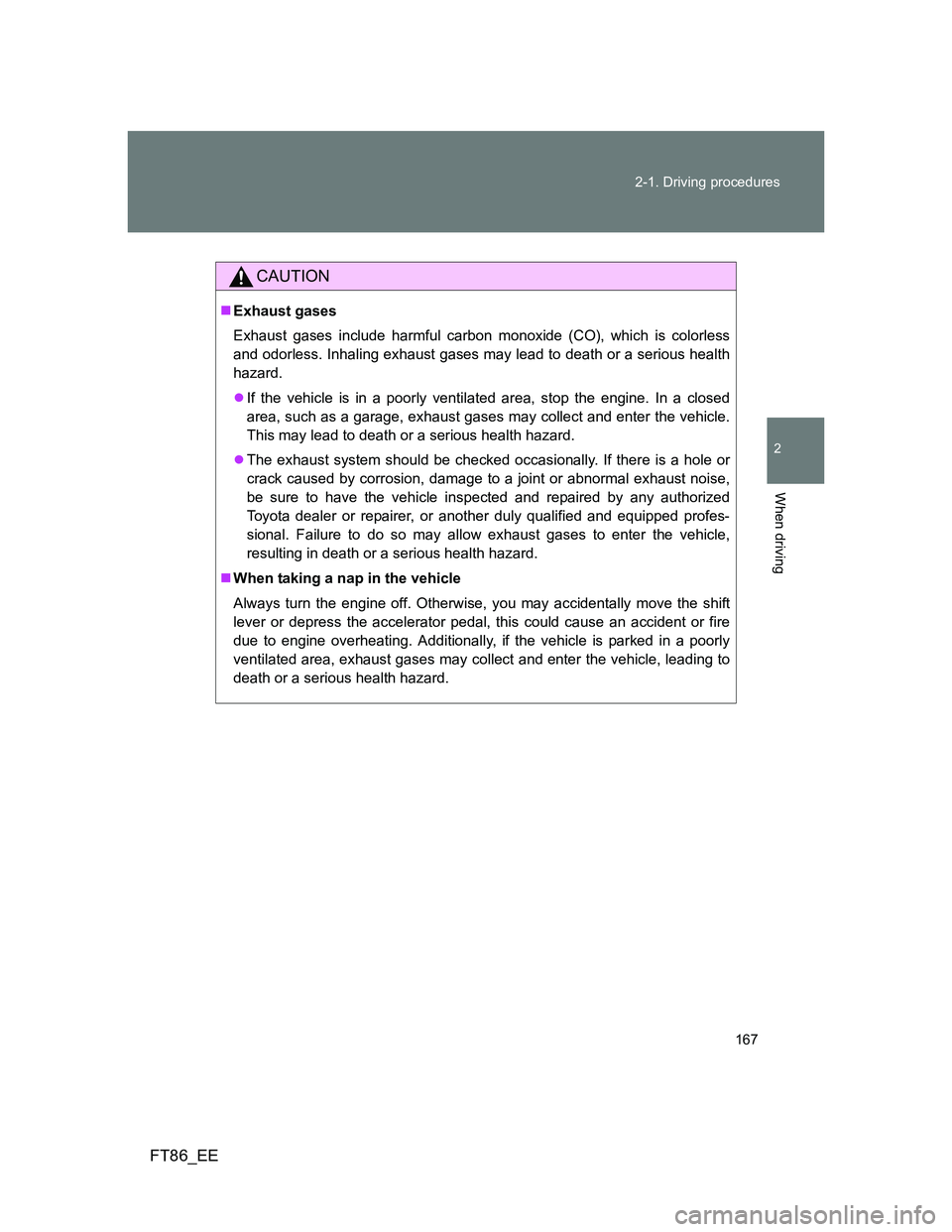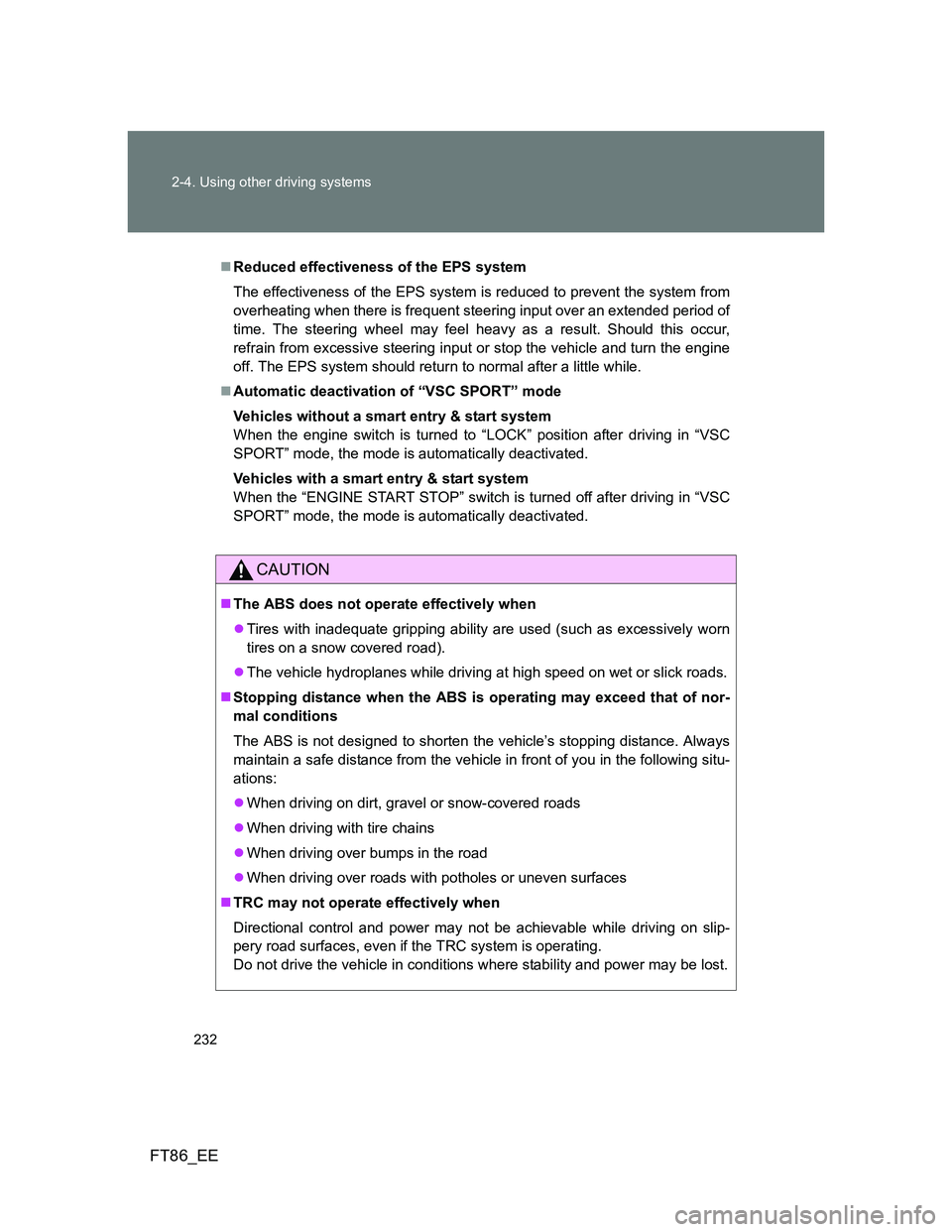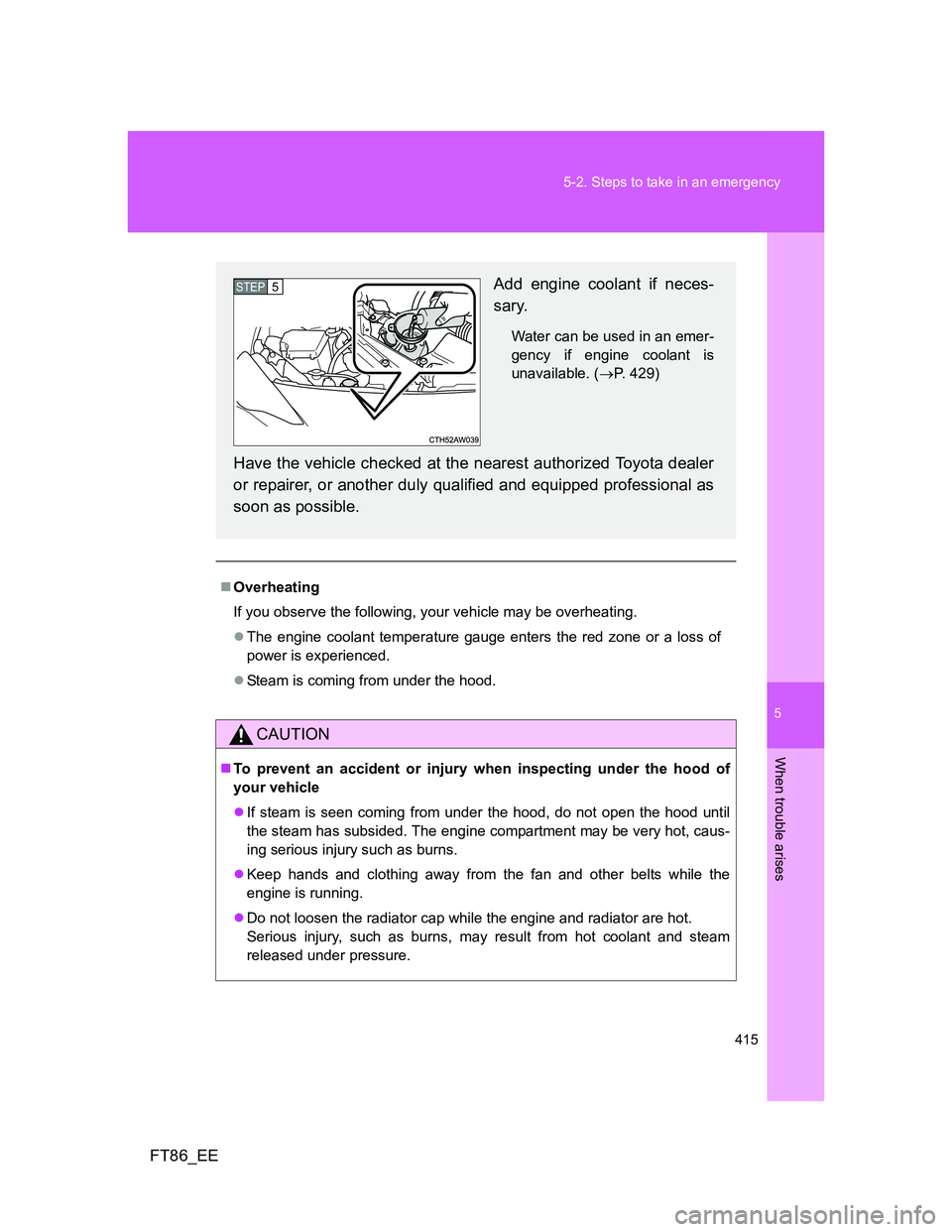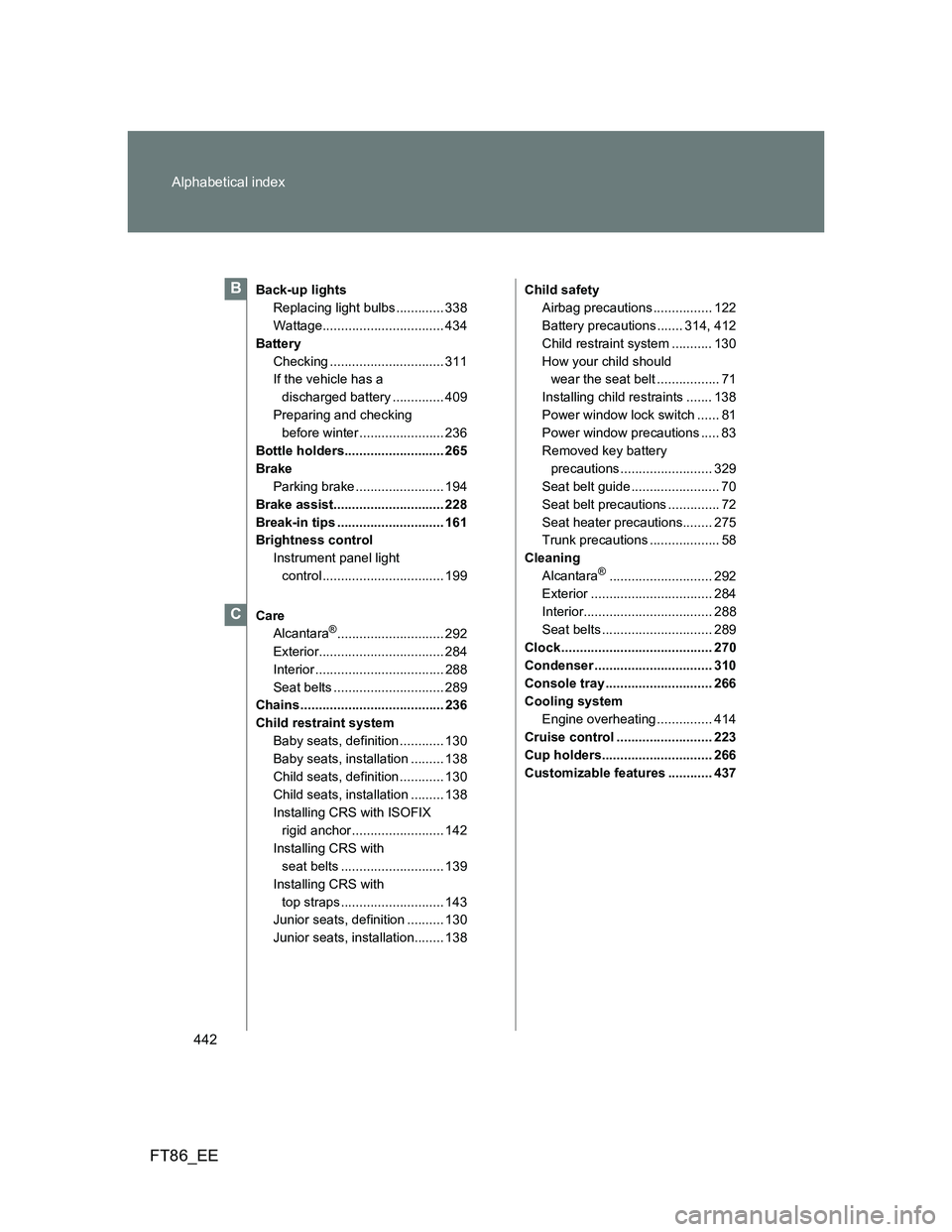Page 167 of 452

167 2-1. Driving procedures
2
When driving
FT86_EE
CAUTION
Exhaust gases
Exhaust gases include harmful carbon monoxide (CO), which is colorless
and odorless. Inhaling exhaust gases may lead to death or a serious health
hazard.
If the vehicle is in a poorly ventilated area, stop the engine. In a closed
area, such as a garage, exhaust gases may collect and enter the vehicle.
This may lead to death or a serious health hazard.
The exhaust system should be checked occasionally. If there is a hole or
crack caused by corrosion, damage to a joint or abnormal exhaust noise,
be sure to have the vehicle inspected and repaired by any authorized
Toyota dealer or repairer, or another duly qualified and equipped profes-
sional. Failure to do so may allow exhaust gases to enter the vehicle,
resulting in death or a serious health hazard.
When taking a nap in the vehicle
Always turn the engine off. Otherwise, you may accidentally move the shift
lever or depress the accelerator pedal, this could cause an accident or fire
due to engine overheating. Additionally, if the vehicle is parked in a poorly
ventilated area, exhaust gases may collect and enter the vehicle, leading to
death or a serious health hazard.
Page 177 of 452

177 2-1. Driving procedures
2
When driving
FT86_EE
When the steering lock cannot be released
Steering lock motor overheating prevention
To prevent the steering lock motor from overheating, the motor may be sus-
pended if the engine is turned on and off repeatedly in a short period of time.
In this case, refrain from operating the engine. After about 10 seconds, the
steering lock motor will resume functioning.
When the smart entry & start system indicator light flashes in yellow
The system may be malfunctioning. Have the vehicle inspected by any
authorized Toyota dealer or repairer, or another duly qualified and equipped
professional immediately.
If the electronic key battery is depleted
P. 326
If the smart entry & start system has been deactivated in a customized
setting
P. 406
Immediately after reconnecting the battery terminals due to replacing
the battery and so forth
The engine may not start. If this occurs, turn the “ENGINE START STOP”
switch to IGNITION ON mode, and start the engine after waiting at least 10
seconds. Idling may be unstable immediately after the engine starts, how-
ever, this is not a malfunction.
The smart entry & start system indicator
light (green) will flash quickly.
Vehicles with an automatic transmis-
sion
Check that the shift lever is set in P. Press
the “ENGINE START STOP” switch while
turning the steering wheel left and right.
Vehicles with a manual transmission
Press the “ENGINE START STOP” switch
while turning the steering wheel left and
right.
Page 194 of 452
194
2-1. Driving procedures
FT86_EE
Parking brake
Usage in winter time
P. 236
NOTICE
Before driving
Fully release the parking brake.
Driving the vehicle with the parking brake set will lead to brake components
overheating, which may affect braking performance and increase brake
wear.
To set the parking brake, fully pull the parking brake lever while
depressing the brake pedal.
To release the parking brake, slightly raise the lever and lower it
completely while pressing the button.
Page 200 of 452
200 2-2. Instrument cluster
FT86_EE
NOTICE
To prevent damage to the engine and its components
Do not let the indicator needle of the tachometer enter the red zone, which
indicates the maximum engine speed.
The engine may be overheating if the temperature gauge is in the red
zone (H). In this case, immediately stop the vehicle in a safe place, and
check the engine after it has cooled completely. (
P. 414)
Page 232 of 452

232 2-4. Using other driving systems
FT86_EE
Reduced effectiveness of the EPS system
The effectiveness of the EPS system is reduced to prevent the system from
overheating when there is frequent steering input over an extended period of
time. The steering wheel may feel heavy as a result. Should this occur,
refrain from excessive steering input or stop the vehicle and turn the engine
off. The EPS system should return to normal after a little while.
Automatic deactivation of “VSC SPORT” mode
Vehicles without a smart entry & start system
When the engine switch is turned to “LOCK” position after driving in “VSC
SPORT” mode, the mode is automatically deactivated.
Vehicles with a smart entry & start system
When the “ENGINE START STOP” switch is turned off after driving in “VSC
SPORT” mode, the mode is automatically deactivated.
CAUTION
The ABS does not operate effectively when
Tires with inadequate gripping ability are used (such as excessively worn
tires on a snow covered road).
The vehicle hydroplanes while driving at high speed on wet or slick roads.
Stopping distance when the ABS is operating may exceed that of nor-
mal conditions
The ABS is not designed to shorten the vehicle’s stopping distance. Always
maintain a safe distance from the vehicle in front of you in the following situ-
ations:
When driving on dirt, gravel or snow-covered roads
When driving with tire chains
When driving over bumps in the road
When driving over roads with potholes or uneven surfaces
TRC may not operate effectively when
Directional control and power may not be achievable while driving on slip-
pery road surfaces, even if the TRC system is operating.
Do not drive the vehicle in conditions where stability and power may be lost.
Page 275 of 452

275
3-5. Other interior features
3
Interior features
FT86_EE
Seat heaters
The seat heaters can be used when
The “ENGINE START STOP” switch is in IGNITION ON mode.
When not in use
Turn the seat heater off. The indicator light goes off.
CAUTION
Burns
Use caution when seating the following persons in a seat with the seat
heater on to avoid the possibility of burns:
• Babies, small children, the elderly, the sick and the physically chal-
lenged
• Persons with sensitive skin
• Persons who are fatigued
• Persons who have taken alcohol or drugs that induce sleep (sleeping
drugs, cold remedies, etc.)
Do not cover the seat with anything when using the seat heater.
Using the seat heater with a blanket or cushion increases the temperature
of the seat and may lead to overheating.
Do not use the seat heater more than necessary. Doing so may cause
minor burns or overheating.
: If equipped
Press the switch to warm the
seats.
The indicator light comes on
when a seat heater is turned
on.
Rapid heating
Normal heating
Page 415 of 452

5
415 5-2. Steps to take in an emergency
When trouble arises
FT86_EE
Overheating
If you observe the following, your vehicle may be overheating.
The engine coolant temperature gauge enters the red zone or a loss of
power is experienced.
Steam is coming from under the hood.
CAUTION
To prevent an accident or injury when inspecting under the hood of
your vehicle
If steam is seen coming from under the hood, do not open the hood until
the steam has subsided. The engine compartment may be very hot, caus-
ing serious injury such as burns.
Keep hands and clothing away from the fan and other belts while the
engine is running.
Do not loosen the radiator cap while the engine and radiator are hot.
Serious injury, such as burns, may result from hot coolant and steam
released under pressure.
Add engine coolant if neces-
sary.
Water can be used in an emer-
gency if engine coolant is
unavailable. (P. 429)
Have the vehicle checked at the nearest authorized Toyota dealer
or repairer, or another duly qualified and equipped professional as
soon as possible.
STEP 5
Page 442 of 452

442 Alphabetical index
FT86_EE
Back-up lights
Replacing light bulbs ............. 338
Wattage................................. 434
Battery
Checking ............................... 311
If the vehicle has a
discharged battery .............. 409
Preparing and checking
before winter ....................... 236
Bottle holders........................... 265
Brake
Parking brake ........................ 194
Brake assist.............................. 228
Break-in tips ............................. 161
Brightness control
Instrument panel light
control ................................. 199
Care
Alcantara
®............................. 292
Exterior.................................. 284
Interior ................................... 288
Seat belts .............................. 289
Chains ....................................... 236
Child restraint system
Baby seats, definition ............ 130
Baby seats, installation ......... 138
Child seats, definition ............ 130
Child seats, installation ......... 138
Installing CRS with ISOFIX
rigid anchor ......................... 142
Installing CRS with
seat belts ............................ 139
Installing CRS with
top straps ............................ 143
Junior seats, definition .......... 130
Junior seats, installation........ 138Child safety
Airbag precautions ................ 122
Battery precautions ....... 314, 412
Child restraint system ........... 130
How your child should
wear the seat belt ................. 71
Installing child restraints ....... 138
Power window lock switch ...... 81
Power window precautions ..... 83
Removed key battery
precautions ......................... 329
Seat belt guide ........................ 70
Seat belt precautions .............. 72
Seat heater precautions........ 275
Trunk precautions ................... 58
Cleaning
Alcantara
®............................ 292
Exterior ................................. 284
Interior................................... 288
Seat belts .............................. 289
Clock ......................................... 270
Condenser ................................ 310
Console tray ............................. 266
Cooling system
Engine overheating ............... 414
Cruise control .......................... 223
Cup holders.............................. 266
Customizable features ............ 437
B
C